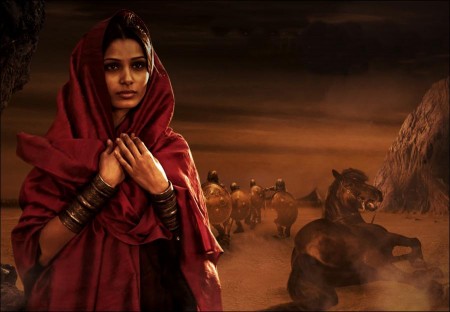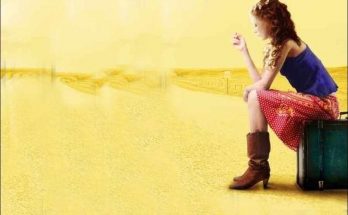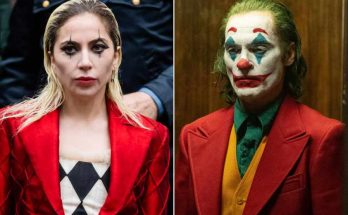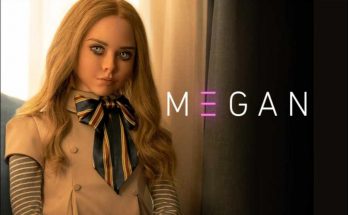Director Tarsem Singh arrived for his first meeting with the producers of Immortals armed with a portfolio packed with reproductions of museum-quality paintings to illustrate his unusual vision for the film. Relativity Media’s Tucker Tooley, an executive producer of Immortals, recalls that this first meeting wasn’t quite what he expected. “He brought in this big canvas and it looked like something you’d see in a museum,” says Tooley. “At first blush, the painting looked very different from how we had imagined the movie, but when Tarsem started to explain, it really made a lot of sense to us.”
He proposed basing Immortals’ visual profile on the work of Caravaggio, the bad-boy painter of the Italian Baroque period. A rule breaker who pioneered the use of live models for religious and mythological subjects, Caravaggio employed a saturated color palette, dramatic lighting, and a feeling of dynamic movement and overt emotion in his paintings. His style broke from the more static work of the Renaissance and earned him both praise and criticism in his lifetime. Singh’s ambitious concept impressed the producers as perfect for the subject matter.
The director worked closely with both the production designers and crew to recreate the luminosity typical of Caravaggio’s work for the overall look of the film. “We call it ‘finger-of-God lighting,’” says Singh. “It’s very focused and seems to come from a far-away source.”
Supervising art director Michael Manson says Singh’s vision and creative courage make Immortals a new and different kind of epic. “We in the art department have a long history with Tarsem, which we cherish,” he says. “I’ve worked with him for close to 15 years, so communication comes fairly easy. It always starts with Tarsem’s interpretation of the script. We take that initial information to research libraries, the Internet and museums. We’ll pull from our collective files for wardrobe, makeup, prosthetics and special effects. Everybody brings something to the table.”
Rather than setting their story in an actual historical epoch, Singh and his designers created an original world for Immortals. “It’s not the Minoan Age or the Bronze Age,” says Charley Parlapanides. “This is the Tarsem Age. It uses the Olympian gods and the Titans, but it has a unique point of view. It’s not a world you will necessarily recognize. For the most part, it is straight out of Tarsem’s mind. He’s made something new and breathtaking, and yet dark and brutal at the same time.”
Costume designer Eiko Ishioka, who earned an Oscar for the spectacular costumes in Francis Ford Coppola’s Dracula, is well known for her designs for film, theater, television and commercials. Ishioka is also a respected visual artist whose work is in the permanent collection of the Museum of Modern Art in New York City. Her iconoclastic worldview falls into the same imaginative territory as Singh’s.
“As far costumes were concerned, we decided early on not to go ‘Classic Greek,’” says Singh. “It would have been counterproductive to hire somebody like Eiko and then tie her hands. There’s no point in telling her, ‘Think outside the box.’ She has no idea what a box is. She comes from a parallel universe.
“At the same time,” the director adds, “this is an action film. I had to make sure that she didn’t make costumes that looked great but couldn’t be moved in.”
The Japanese costume designer, who studied design and art before she started working in film, says she approached the costume design for Immortals as a creative collaboration set in a fantasy world. But she realized that her flights of fancy needed to be based in physical reality and enjoyed collaborating with the actors to make her ideas work in a practical sense. “During the fitting process, my ideas are pretty crazy,” she says. “To make sure the costumes are functional, I ask the actors for help. I feel the actor and designer should collaborate.”
Freida Pinto found the process exhilarating and ultimately essential to the creation of her character. “Eiko designed these beautiful costumes for everybody,” says Pinto. “But it took some effort to make them your second skin. You had to maintain a certain posture in order to make them look that beautiful at all times, but they were essential to taking the film into that larger-than-life realm. I wear this amazing red corset with a sheer red skirt and a black veil. When I put it on, I felt it against my skin and I was very confident about it. There was nothing vulgar about it. It was revealing in the right spots and just the way it needed to be. Her idea of female sexuality and sensuality is so beautiful.”
Kellan Lutz found Poseidon’s ornate costume challenging, especially during the film’s battle sequences. “I wore a big Pisces helmet that was very tedious to fight in,” he says. “It was actually difficult just to act in. I couldn’t really hear because I had these seashells on my head. It sounded like the ocean. I also kept hitting myself with Poseidon’s trident.”
For Ishioka, the most difficult task in creating the costumes was achieving realistic armor. “I wanted to use shiny materials for a mask or helmet,” she says. “But the reflective surfaces would have interfered with shooting on a green screen. I didn’t want it to look fake, like a breast of armor made of wood or that kind of thing. It had to be not too shiny but I also want the audience to believe that this armor is made of metal.”
Ishioka’s original designs are complemented by the work of makeup designer Nikoletta Skarlatos. “Tom Foden, the production designer, sent me a visual tour of the sets so I could start to visualize the people,” she says. “I did a massive amount of research before presenting ideas, because I’m a huge fan of both Tarsem and Eiko. They both inspire me and I knew this would be a chance to do something really extraordinary. In terms of references, I looked at mythology, but I also wanted to create something that had not been seen before.
“It’s a very makeup-intensive movie,” says Skarlatos, explaining that advances in technology have raised the bar for her craft. “3D is very specific and you see things more obviously. High-def and digital shooting magnify that effect. We tried to be very precise.”
Skarlatos worked closely with Pinto to create Phaedra’s look. “The eye make-up is not a traditional Indian look, nor is it a contemporary look. It’s a very different and mysterious look, with certain little nuances that allude to the fact that she is an Oracle, a very special being.”
Hair and make-up helped Pinto slip into the skin of the mystical Phaedra. “They tried these colors in my hair that I’d never had done before,” she says. “We added some extensions and a braid. It made me feel like I was from that period. I would come in with my jeans and T-shirt, get into my robe, and there would be a completely different person there: Phaedra.”
Skarlatos, whose previous credits include Pirates of the Caribbean: At World’s End and Thor, was also involved in creating the blood and special effects makeup. “It can be darkened, but what you see is what you get, so we had to work with the DP to create the right blood for night and the right blood for day.”
Related Link: Read the Full Production Notes for Immortals
Views: 504



